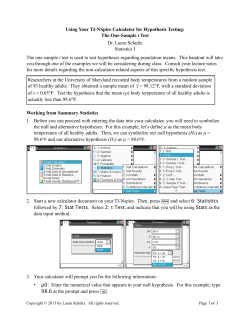
Investigating Behaviour Unit 2
Investigating Behaviour Unit 2 Unit 2 O Understand experimental and non experimental methods. Tested by: O Nab (20 marks) O Research Investigation (completed as course work and sent to SQA before Easter hols. O Series of questions on a given scenario worth 20 marks in final exam. Experimental Basics O Experiment O Variables O Independent variables (IV) O Dependent variables (DV) O Hypothesis O One tailed O Two tailed O Null Tasks O Listen to the following 2 experiments and for each write down: O What was the IV? O What was the DV? O A one tailed, two tailed and null hypothesis O Memory Experiment Group 1 words O Ball O Dog O Bag O Fall O Milk O Telephone O Wheel O Picture O Cat O Winter O Bicycle O Rabbit O Computer O Comedy O Front O Sky O Basket O Nails O Summer O Television Group 2 Words O Paper O Notepad O Flat O Jewellery O Chocolate O Files O Table O Lion O Swing O Pen O Tiger O Burger O Hall O Flowers O Climb O Ice Cream O Duck O Internet O Seesaw O Glasses For this experiment: O What is the IV? O What is the DV? O What would the one-tailed hypothesis be? O What would the two-tailed hypothesis be? O What would the null hypothesis be? O Which hypothesis was supported? Task 3 O For each of the following questions answer: a) Identify the IV and DV b) How could you operationalise the IV? How could you operationalise the DV? d) Write a fully operationalised one-tailed hypothesis. e) Write a fully operationalised two-tailed hypothesis c) Do older people sleep more or less than younger people? 2. Do people rate food as more attractive looking when they are hungry? 1. Experimental Design O Repeated Measures – when participants complete all conditions (as our memory experiment) O Independent Groups – when participants only complete one condition. O Matched Pairs - uses independent groups but each participant in group A is paired with a participant in group B based on a predetermined participant variable eg age, IQ, gender, etc Evaluation O Repeated Measures (the one we used) O One test may have been more difficult than the other. – Random allocation would counter this. O By second test participants may have guessed purpose which will affect behaviour – Single Blind Design would counter this. O Order effect. By second test the participants are either more practised or are bored which would confound the results (confounding variables) - counterbalancing O Independent Groups O No control for participant variables – group A might just be more able. – Randomly allocate participants/matched pairs O Need more participants O Matched Pairs O Time consuming. O Can’t control all variables. Design O For each of the following write down whether they are repeated measures or independent groups: 1. Boys and girls compared on their IQ test. 2. Hamsters are tested to see if one genetic strain is better at finding food in a maze compared with another group. 3. Reaction time is tested before and after a reaction time training activity to see if test scores improve. 4. Participants memory tested in the morning and afternoon. 5. 3 groups of participants tested to see if nouns, verbs or adjectives are easier to remember. 6. Participants are asked to rate photos as attractive or unattractive. Task O A psychologist conducted a study to test whether visual imagery helps memory. There were 2 lists to be recalled – one with words and one with pictures. 1. Describe how this experiment could be conducted for each of the 3 designs. 2. Which would be best? Explain your answer. 3. For which would counterbalancing be necessary? 4. How would you design the counterbalancing? Extraneous Variables O Experimenter Variables (Eagly & Carli, 1983; Rosenthal, 1966; Rosenthal and Fode, 1963) O Personal variables. O Demand Characteristics O The Hawthorne Effect O Age O Intelligence O Experience etc O Situational Variables O Order effects O Time of day, temperature, noise, Mr Haldane entering the room. How to control these variables O Pilot Study O Standardised Procedures. O Ensures all participants are tested under the same conditions to counter any situational variables. O Standardised Instructions. O Like a script – counters investigator effects. O Double Blind Design. O Neither the participant or the person conducting the experiment knows the aims of the study Experiment and Control Group O In order to assert that an IV has affected the DV the experiment needs to be carried out in comparison with the results of the experiment without the DV. O For example: The Drunken Goldfish O Control group – no alcohol O Experimental group – alcohol. O NB if carried out with repeated measures design it is called control conditions and experimental conditions Different types of experiments O Laboratory O Know they are taking part in the study. O Low in mundane realism. O Extraneous variables easier to control. O Field O High in mundane realism. O Don’t always know they are part of an experiment. (ethics?) O Difficult to control extraneous variables. O Natural O Not always appropriate to change IV O Participants may be biased. O Causal conclusions can not be drawn as the IV has not been deliberately manipulated. Task O The class will be divided in to 5 groups. Each group needs to find the mean, median and mode of their topic. 1. No. of coloured paper clips. 2. No. of coloured pins. 3. No. of SG passes at Credit level. 4. No. of hours slept last night. 5. No. of siblings (including step and half siblings). O You must design this task yourself and decide what is the best way to collect the data etc.
© Copyright 2025




![[35] The Default Bayesian Test is Prejudiced Against](http://cdn1.abcdocz.com/store/data/001092197_1-5d6aeaa424ad1857b9e3610bc24d4fcf-250x500.png)
















